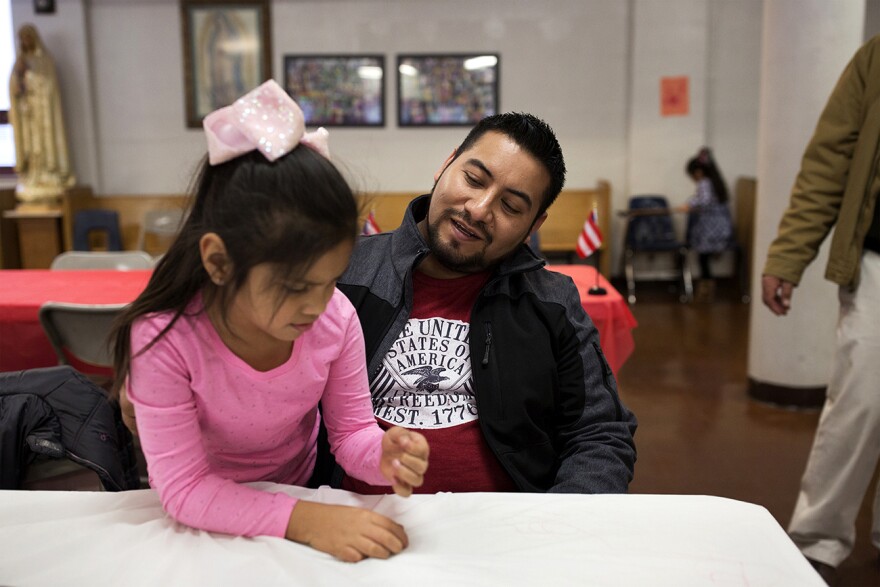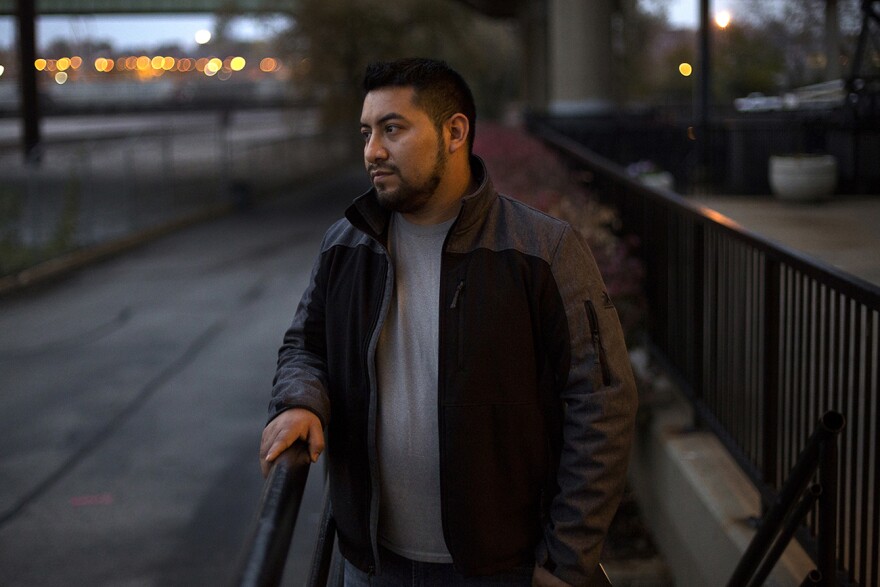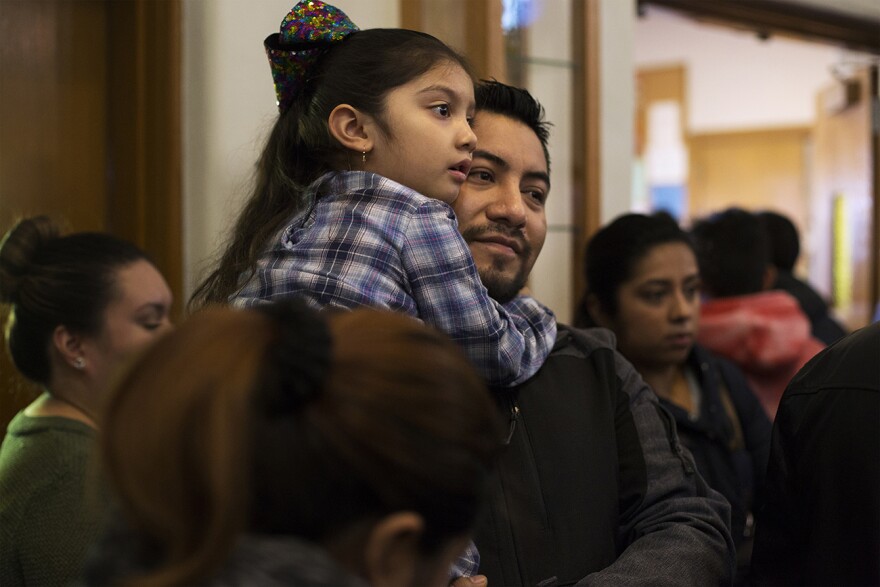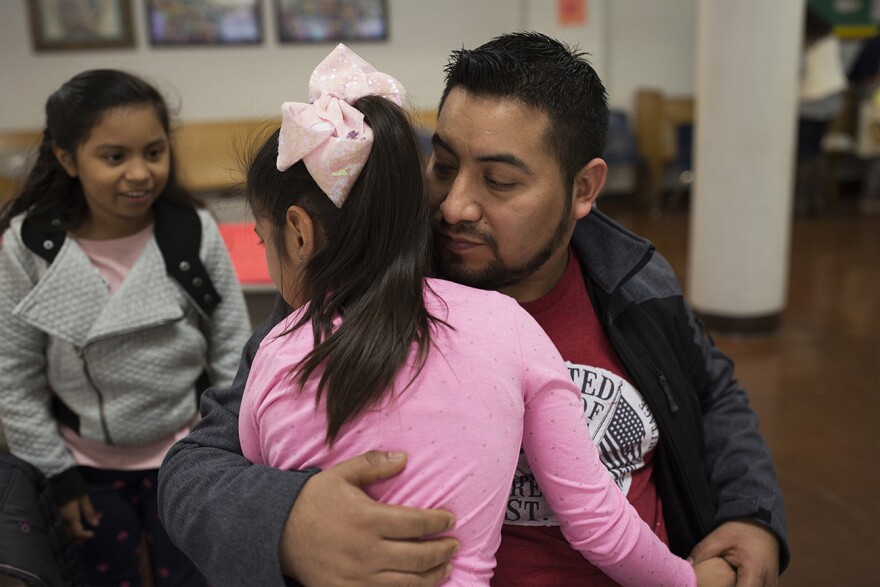Jose Garcia and his partner, Ana Ortiz, shuffled quietly into the warmth of a packed Sunday Mass at Our Lady of Guadalupe in Ferguson.
Their older daughters, Julissa, 11, and Dana, 7, disappeared into the pews looking for friends. Garcia picked up 5-year-old Amanda and rocked her in his arms.
For more than a decade, Garcia attended Sunday Mass with his family. But this November morning was different.
The next day, he would board a flight with a one-way ticket to Mexico City.
Loading...
He told his daughters that he needed to visit his mother in the city where he was born, and that he’d be back soon. The truth was he was being deported. He didn’t know if he’d ever return.
Under the Obama administration, immigration authorities allowed many unauthorized immigrants to stay in the United States with their families as long as they checked in regularly and didn’t break any laws. Now, advocates say, those who have spent years following the rules set out for them have become the easiest targets for deportation under the Trump administration.

Shifting priorities
Jose Garcia was just one month shy of his 15th birthday when he first left behind everything he knew. The decision wasn’t easy. But, he thought, in the United States he would at least have a chance at a better future. So he left his hometown of Toluca, Mexico, and headed north.
“All for a dream,” he said. “A dream that you know could very easily turn into a nightmare. But you take the risk – for the chance to get ahead.”
Once in St. Louis, Garcia enrolled in English classes and started working at IHOP. A few years later, he met Ortiz. On their first date, he took her to downtown St. Louis. They both lived in Overland and she’d never been to the city. They talked for hours and lost track of time. He described it as one of the best days of his life. Eventually, they started a family, bought a house and built a life together.
Garcia, now 30, lived under the radar of immigration authorities for years. Then in 2009, a friend borrowed his car and got into an accident, which he said led authorities to discover his legal status. He was ordered to leave the United States but was then granted several year-long stays of removal — temporary relief from deportation — that let him stay as long as he continued to check in with immigration officials.
Though the Obama administration deported record numbers of people, the focus was primarily on deporting unauthorized immigrants who were violent criminals, terrorists or recent arrivals. In 2014, President Barack Obama directed U.S. Immigration and Customs Enforcement agents to overlook those who had lived in the U.S. for years and had deep community ties and no criminal records. Under this new directive, Garcia continued to check in with an immigration agent, but didn’t need to request any more stays of removal.
When President Donald Trump took office, immigration priorities changed. As a presidential candidate, Trump promised massive crackdowns on illegal immigration. Five days into office, he issued an executive order that broadened the scope of who is considered a priority for deportation.
Across the country, immigration agents began detaining and deporting people who had routinely checked in without consequence for years. Everyone in the United States without authorization immediately became a target.
Garcia started hearing stories about the policy shift in February. Worried he’d be detained at his next scheduled check-in, he called his lawyer and his immigration agent and found out his only option was to request a new stay of removal.
At his September check-in, he was told his request had been denied. He could either be taken to a detention center to await deportation or he could buy himself a plane ticket and carry out his removal order on his own. The second option gave him an extra 60 days, but he would have to wear an ankle monitor and check in weekly.
Garcia remembers asking his agent about the extra supervision.
“I’m not running,” he said he told him. “I’ve followed the program for almost eight years and I’ve never done anything wrong. And they said, ‘Well, the policies – they’re different now.’”

Increasing deportations
Immigration reform advocates say the shift in deportation priorities is an easy way for the Trump administration to quickly boost its deportation numbers as fewer people try to cross the border. Department of Homeland Security numbers released in early December show border apprehensions are at a record low. But since Trump took office, deportations from within the country jumped 37 percent over the same time period last year.
“By President Trump saying everyone is a priority, then no one is a priority,” said Jessie Chappell, an immigration lawyer who helped Garcia prepare documents before his deportation. This, she said, allows ICE to go after the “lowest hanging fruit possible” – people who’ve faithfully followed the rules set out for them for years.
“I’ve never seen a bigger waste of resources than focusing on families,” Chappell said. “You just took a thriving family who’s contributing to the economy and broke them.”
The latest statistics show that from February through September of 2017, deportations of immigrants with no criminal records in Missouri and nearby states nearly doubled – from 333 to 643 – compared with the same time period last year. The agency groups Missouri with Kansas, Iowa, Nebraska, North and South Dakota and Minnesota.
“The president has made it clear in the executive order – there’s no population off the table,” Thomas Homan, acting director of ICE, said in a news conference to announce the numbers.
“If you’re in this country illegally, we’re looking for you and we’re going to apprehend you.”

“You have to be strong”
Days before attending his final Mass at Our Lady of Guadalupe, Garcia stood in the small waiting room of an ICE field office in downtown St. Louis. A mostly-bare bulletin board displayed a small American flag and some MapQuest printouts – directions to three regional detention facilities operated by small county jails.
Garcia’s priest, Father John O’Brien, stood by his side. Four strangers – a small collection of activists and clergy – sat quietly beside them. They came to show support as Garcia finalized the last of his deportation paperwork.
In the drab waiting room, Garcia worried about his three young daughters. He and Ortiz had decided to tell them he’d only be gone a few months. They thought it would make the goodbye a little easier, a little less agonizing.
But the girls were already distraught over the idea of their dad leaving them – even just for a few months.
They wanted to know when he’d be back. An exact date, Dana demanded, so she could doodle his return into her calendar.
“They’re going to suffer, emotionally, a lot,” Garcia said. “I’ll have to apologize to them and say, ‘Hey, I don’t know if I’m going to see you again, but you have to be strong. You have to support your mother.’”
Father O’Brien reassured him the church would keep his family close. “We might be further apart than we like for a time but you’re still part of our community. And you’re still a part of this country, as far as we’re concerned.”

Saying goodbye
During their last weekend together, Garcia promised his daughters a day filled with their favorite things. They went to Chuck E. Cheese’s, Amanda’s favorite place, and then to see a cartoon movie about the birth of Jesus. And finally, a dinner at California Pizza Kitchen, another family favorite. It was the perfect day.
Now, one day before his one-way flight to Mexico, Garcia sat with his partner as their daughters played with friends after Mass. He thought about what he would say as he tucked them into bed, knowing even the quickest scenario for his return requires him to wait 10 years before seeking permission to re-enter the U.S.
“I’m going to tell them I love them so much and that they’re my life,” he said, looking toward the floor. “And that even if I’m not physically present, I’m going to be with them spiritually.”
“I don’t want to see them cry,” he added. “It’s going to break my heart in half.”
Next to him, Ortiz started to tear up.
“It’s really difficult because you have this feeling of helplessness,” she said with a sigh. “You can’t change anything. You wish for it to all to be a nightmare and that you’ll wake up and things will be different.”
Garcia took her hand and looked into her eyes.
“Lo siento mucho,” he said, quietly. I’m so sorry.
“No, no es tu culpa.” No, she told him, it’s not your fault.
“No es tu culpa.”
Follow Carolina on Twitter: @CarolinaHidalgo



